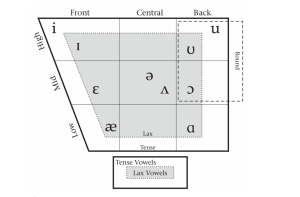12 Describing Vowels
Depending on the dialect, English can present different sets of vowels. For this course we are going to focus on the following 10 vowels which are used by the majority of speakers of American English:
[i] as in heed: [hid]
[ɪ] as in hid: [hɪd]
[ɛ] as in head: [hɛd]
[æ] as in had: [hæd]
[ə] is found in unstressed syllables, as in the word photographer – [fəˈtɑɡɹəfəɹ].
[ʌ] as in blood: [blʌd]
[ɑ] as in lock: [lɑk]
[ɔ] as in law: [lɔ]
[ʊ] as in hood: [hʊd]
[u] as in boot: [but]
Because vowels are produced with a relatively open vocal tract, they do not have a consonant-like place or manner of articulation. They are also always voiced. This means that the three standard descriptors for consonants (place, manner, and voicing) are not helpful when we want to describe vowels. In the case of vowels, there are four main ways in which speakers can change the shape of the vocal tract and thus change the vowel they are producing.
- First we have height. Vowels differ when raising or lowering the body of the tongue. For example the sound [i] requires the raising of the body of the tongue while the sound [æ] requires the lowering of the body of the tongue.
- Regarding backness, sounds like [i] require the advancing of the body of the tongue, but it is retracted in sounds like [u]. Try producing these two vowels and you will see how you need to change the disposition of the body of the tongue in your mouth.
- Regarding the rounding of the lips, some vowels like [ɔ] require lip rounding while others do not require rounding like the sound e which is produced by stretching your lips
- Tenseness. Vowels that are called tense are said to have more extreme positions of the tongue and/or the lips than vowels that are lax. The production of tense vowels involves bigger changes from a mid-central position in the mouth. That is, they require a more extreme tongue gesture of raising, lowering, advancing, or retracting in order to reach the periphery of the possible vowel space. This means that the tongue position for the tense high front vowel [i] as in the word beat is higher and fronter than for the lax high front vowel [ɪ] as in the word bit.
So in order to familiarize ourselves with the description of vowels, we can use the following chart.

For example, the sound [u] is described as high, back rounded and tense.
The sound [ɔ] is mid back rounded and lax
The sound [æ] is low front unrounded and lax
And regarding the two vowels that share the central space, we are going to differentiate them this way, this schwa [ə] sound is going to be a mid central unrounded lax vowel, and the [ʌ] sound as in blood is going to be a mid-low, central unrounded and lax vowel, because one is a bit lower than the other.
Adapted from:
Anderson, C., Bjorkman, B., Denis, D., Doner, J., Grant, M., Sanders, N. & Taniguchi, A. (2022). Essentials of Linguistics. Pressbooks. https://ecampusontario.pressbooks.pub/essentialsoflinguistics2/

